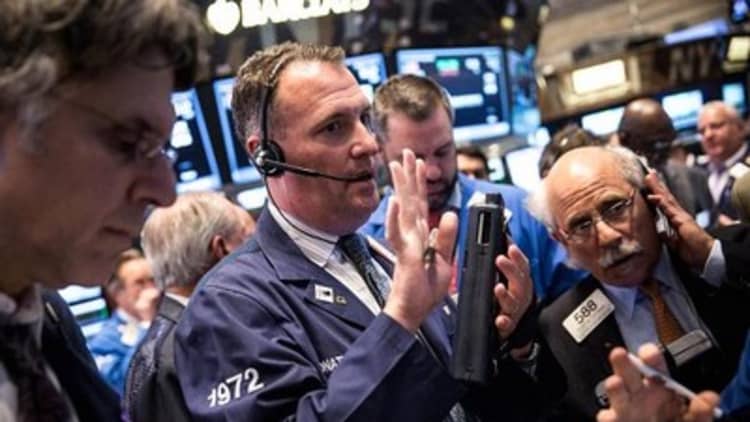
Treasury yields ripped higher Monday and early Tuesday, putting pressure on stocks and signaling a possible sea change in the global rate environment.
The move in yields on the 10-year note and 30-year bond was surprisingly rapid and violent, and strategists were hard pressed to pinpoint a specific reason for the shift. Markets will now focus on rates Tuesday, to see if Monday's high yields are just the starting point for a new trading range.
Traders in the futures pit in Chicago characterized the move as being similar to a "global margin call," where each tick higher in yield into new territory forces more repositioning. The shift higher in rates then becomes self-fulfilling until there is a capitulative spike.
"This is starting to become a bad omen. This is not good. There's enough leverage out there in different forms, where if this is the end of the 'easy money, low long-term rates' story and the Fed is not going to be able to hike, the long-term interest rates market is going to do the tightening for the Fed, and this will be bad for most financial assets," said George Goncalves, head of rate strategy at Nomura.
"If this move is really a referendum on central bankers providing too much liquidity and if this is the hangover part, it could go much further," said Goncalves.
The sharp move higher in rates caught many in the markets by surprise, since Friday's post-jobs report decline in yields seemed to be setting the stage for consolidation. But U.S. yields followed European yields higher Monday and then moved even further on their own.
Bond yields have been moving higher for two weeks now, after the reversal in European sovereign yields, particularly the bund. The market had viewed Friday's jobs report to be neutral enough to keep Fed rate hikes on hold until the fall.
"There's relatively little going on right now so it seems like a situation where even though rates backed up to a level that we haven't seen in quite some time, it feels like nobody wants to be the first one in the pool because they're just not sure where it's going to go," said Ward McCarthy, chief financial economist at Jefferies. He said the lack of liquidity in the bond market was helping to exaggerate the move.
"The bond market is getting beaten like a rented mule," said McCarthy. "I think it's one of these situations where it's the early stages of (quantitative easing). QE has always caused some counterintuitive market behavior. I think right now, we're in the early stages of ECB (European Central Bank) QE." Even before the ECB embarked on its QE program, European yields headed lower to the point where the German 10-year had been closing in on a zero rate, before switching direction.
The U.S. 10-year touched a high 2.28 percent Monday and the 30-year bond yield reached a high of 3.05 percent for the first time since November. The selloff accelerated and stocks fell with it in afternoon trading.
"That it's happening with mediocre growth tells me this is a major headwind," for stocks, said Peter Boockvar, chief market analyst at Lindsey Group. The Dow fell more than 100 points but recovered some losses late in the session, closing down 85 at 18,105.
"This is a global trend change," said Boockvar, pointing to the decline in European yields. He also highlighted a bottoming in commodities prices, which has some traders betting that inflation will re-emerge, a trigger for the Fed to raise interest rates.
"The bond's been bleeding all morning. European bond markets traded poorly. The more the day went, the 10-year yield was up another tick. There's obviously a trend change going on. Rallies are now being sold. They're all giving back Friday's rally. There's a big-time change going on in the global bond market."
The market is now focused on three auctions this week and whether the selloff will stabilize. The Treasury auctions $24 billion in three-year notes at 1 p.m. EDT Tuesday. But the most important are the $24 billion 10-year note auction Wednesday, and the $16 billion in 30-year bond auction Thursday.
"I thought we dodged the bullet last week. The key is going to be how these auctions are taken down," said Goncalves. "They're big auctions. If people are actually interested in buying them because there's value, they'll overlook the weird momentum. If they don't, it means the strong hands didn't step in."
Besides the auctions, there is the JOLTS report on job openings for March at 10 a.m. EDT Tuesday, and the NFIB small-business survey is released at 9 a.m. As for data, markets are most focused on Wednesday's retail sales report.
San Francisco Fed President John Williams speaks at 12:45 p.m. EDT in New York, and New York Fed President William Dudley participates on a panel in Switzerland at 3:15 a.m. EDT on the implications of diverging monetary policy.
McCarthy said the rise in rates won't hurt the economy, but the move up in the 10-year will show up in mortgage rates. The move higher could get some borrowers off the sidelines if they believe the shift will continue, he said.
"It's a relatively low-volume trade. It's not capitulation as much as it is reluctance to stand in front of the move," said Ian lyngen, senior treasury strategist at CRT Capital. He said some market players were pointing to the upcoming auctions as a reason for the selling but that didn't make sense.
"The selloff in Treasurys is outpacing the selloff in bunds today," he said, adding Mondays are notoriously low-liquidity days.
—CNBC's Rick Santelli contributed to this report.


